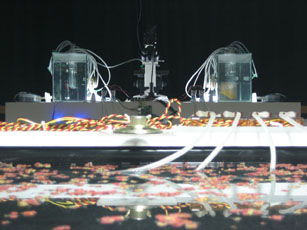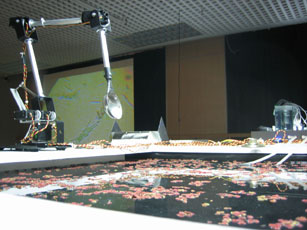Bacteria culture
The artist hostprods describing Autoinducer_Ph-1 (cross cultural chemistry) (2006), robotic arms tending a rice paddy, controlled by AI modelling software interacting with synthetic and organic bacteria:


There's video at the site. Examine some other projects too, like Phumox (2005).
That's a truth in just about any context.
Both the organic and synthetic bacteria are aware of the state of their symbiotic partner via traditional chemical detection methods. As a denizen of an electronic environment, GCS [Generalized Cellular Signaling] bacteria signals are converted into signals that control various actuators and thus the regulated environment in which the bacteria are being cultured. Through this interface, the synthetic bacteria are fully integrated into the ecosystem and exert an equal influence on the system equilibrium. In addition to producing a chemical response, certain GCS signals are translated into sound and light rounding out the environmental stimuli of the ecosystem. The sum effect is a system in flux, one that teases the Anabaena and Azolla into behaviour distinct from the natural. ‘Autoinducer_Ph-1’ employs a pair of robotic arms to deliver Azolla to the growing rice as and when the GCS/Anabaena symbiotic brain decides. Although starting out with basic behaviours the arms evolve a more and more expressive mode of operation as the piece continues.


There's video at the site. Examine some other projects too, like Phumox (2005).
A crucial part of Phumox is the recognition of emergent behaviour in organic and artificial systems and how these organic and artificial systems can be juxtaposed to produce emergent behaviour through symbiotic or parasitic activity. Exploring these boundary conditions is the focus, as the most dramatic events occur not in equilibrium but in change [emphasis mine].
That's a truth in just about any context.





0 Comments:
Post a Comment
<< Home